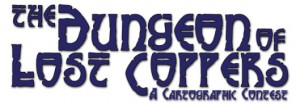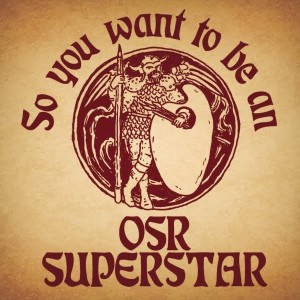There are a lot of acronyms used in Role Playing Games. Below is a list that will be expanded as needed. As a work in progress, I have items that I have added but not yet added a description. This will be forthcoming. Those things that are most critical to following along I tackled first. I will address others as time permits.
It takes too long to keep defining every acronym in every article. To make it easier for all concerned, I have added this article to the link bar on the right.
You can download a PDF of this article here.
RPG = Role Playing Game. Role as in pretending to be someone else.
Roll Playing = A form of play that is more focused on rolling dice and third person descriptions of the actions of one’s character. It is looked down upon by some Role Players.
LARP = Live Action Role Playing. Dressing up and playing out a scenario with a group. While some who play RPGs might dress as a character or dress in a costume for a convention, or maybe even during play, not all who play RPGs have LARPed and not all who LARP have played RPGs. As a kid, dressing up like a cowboy or a soldier is the only LARPing I have done. If you think about it, Civil War reenactors are historical LARPers. Actors on stage or screen are LARPing too.
FLGS = Friendly Local Game Store. They sell RPGs and a variety of other kinds of games. They often sell comic books, video games, and many other kinds of games. They often have a place to play games, either in a specified area with tables, and many have one or more rooms or areas available. The often host tournaments of various games, or have regularly scheduled types of games on certain days of the week or other regular schedule. If one is looking for a game to join, or players to play, this is a good resource for local players. It is recommended that you buy your gaming supplies from your FLGS to help keep them in business, rather than buying everything online, even if it costs a little more.
d# & #d# – d4,d6,s8,d12,d20, d% stand for 4, 5 6 8 12, 20 sided and percentile dice. 2d6 means roll 2 six-sided dice. Percentile dice are two ten sided dice, the first one or the one of a designated color is the tens and the other is the ones. If both come up 10 or 0, it means 100%. If the first is 5 and the second is 6, it means 56%. There are specialized dice now that have 1-10 (0) and 10 to 100 (00), so that different colored dice or rolling twice are eliminated.
PC –Player Character. A character contolled by a player.
NPC – Non-Player Character. A character controlled by the Game Master.
DM – Dungeon Master. The referee of the game. The referee presents the scenario for the players and rules on what they can and can’t do based on the rule framework. DM is usually reserved specifically for D&D, or more broadly, fantasy RPGs.
GM – Game Master. Generic term for the game referee. Some game systems have their own term for the game master. For example, CK for Castle Keeper in Castles & Crusades by Troll Lord Games.
TSR – Tactical Studies Rules. Name of the company that produced D&D. Later sold to Wizards of The Coast.
WotC – Wizards of the Coast. Bought TSR. WotC is now a business unit owned by Hasbro.
PH – Player’s Handbook. Usually specifically the D&D, the rulebook for players.
MM – Monster Manual. Usually specifically the D&D, the rulebook with the creatures one can encounter in the game. One can invent one’s own creatures or modify the existing ones.
DMG – Dungeon Master’s Guide. Specific to D&D. the rulebook used by the DM to help frame and interpret the rules.
Chainmail – This was a booklet with a set of rules for playing heroes on the battlefield using medieval miniatures. This gave the spark that led to D&D by Gary Gygax and Dave Arneson.
OD&D – Original Dungeons and Dragons. These rules were packaged in a white box, thus they were the White Box set. Published in 1974, this is what started it.
Basic – This is usually referred to as the Blue Box set and was a collection of the rules put together in a more logical framework but only covered up to 3rd level characters. It was meant as an introduction to get players to buy the White Box set. This is also known as the Holmes rules for its author Dr. J. Eric Holmes.
Expert – This was another restatement of the original rules and is referred as the Moldvay rules, as Tom Moldvay was the editor. This box was a magenta color.
BECMI – Refers to the Frank Mentzer 1983 edition of Basic, Expert, Companion, Masters, and Immortals Dungeons & Dragons. These rules were packaged in a Red Box.
Blue Box – See Basic Above.
Red Box – See BECMI above.
AD&D – Advanced Dungeons and Dragons. This was a revision of the rules that was a collection of ideas from issues of Dragon Magazine. It was organized in a way that took one step by step from creating a character and explained what each ability allowed a character to do and what each type of character could do. This edition took the focus of rules and most of the sales were here. Originally this consisted of the three core rulebooks of the Player’s Handbook, Monster Manual, and Dungeon Master’s Guide. Later books included the Fiend Folio (a collection of monsters and creatures, Monster Manual II, Unearthed Arcana, Oriental Adventures, Wilderness Survival Guide and Dungeoneers Survival Guide.
1E – First Edition of AD&D, usually just AD&D.
2E – Second Edition AD&D. This was a revision of the rules that added new rules and revised, clarified, or eliminated old rules. This was the last version produced by TSR. I had some experience with this rule set, but very limited.
3E – Third Edition. this was a major revision of the rules. I have no experience with this. A lot of under 40 players got their start with this. There is still a lot of controversy about it among some bloggers.
3.5 – This was a revision of the 3E rules. I have no experience with it. This was a like it or hate it for those who started with 3E.
4E – This was a revision of the 4E rules. I have no experience with it. I got into following the OSR bloggers and learned about it. There was a lot of controversy about it. Some likened it to trying to emulate WOW (World of Warcraft) on paper.
5E – This is the current revision of the rules that underwent a year+ beta period. It is slated for release in the summer, 2014. It is also called D&D Next. I signed up to get the beta materials and it is a streamlining of the rules back to the spirit of the original/1e days. Many see it as a response to the OSR. The base rules will be available as a free PDF, so one can get the basic information needed without a large cash outlay to play.
D&D Next – Official name for the fifth edition rules.
OGL – Open Gaming License. WotC released a lot of game information and material in an open license. This allows those who accept the license to use it as long as they follow the license and include it in any material they release. This has led to a lot of fan and competitors of WotC producing rules that clone the functionality of earlier versions of D&D. The OGL also covered modern and science fiction rules. Also referred to as the d20 rules. I am no expert on all this. Google is your friend. Search for more on this. As for the legal aspect of the OGL consult a lawyer.
OSR – Old School Renaissance or Old School Revival. Players who like the original D&D or AD&D rules/style of play. They either relied on the availability of PDFs of the original rules when they were originally available. WotC later took them down when someone posted their copy of the PDFs online so anyone could download. A couple of years ago the PDFs were re-released and are still available. In the time when those rules were unavailable, many relied on the OGL to build their own set of rules. Some developed their own set of rules before the whole PDF take down.
Retro Clone – A set of rules that mimic the mechanics or either Original, Basic, Expert, or Advanced D&D. This was enabled by the OGL and the interest of many who yearned to play the way they remembered. Some retroclones are Swords & Wizardry, Microlite, Pathfinder, Castles & Crusades, Legends & Lore, ACKs (Adventurer, Conqueror, King), to name a few. Some of these are available for sale some for free, some have been developed by an individual. Because of the clone nature of many of these products, supplemental materials and rules are easily adapted or interchangeable between systems.
Monty Haul – Term used to describe a DM who rewards players far above and beyond the risks and challenges presented by the adventure. Monty Hall was a game show host in the 70s and 80s for the original Let’s Make a Deal.
TPK – Total Party Kill. This describes a situation where for whatever reason, the entire party is killed in the course of an adventure. This can be from the party having exceptionally bad rolls, making really bad decisions, and unbalanced encounter or adventure, or even malice on the part of the DM. Starting characters are not very powerful and it is most often that TPKs happen with low level characters, but they can happen with more powerful characters.
Rules Lawyer – A player who argues minutiae of the rules with the DM to the point of distraction and aggravation of both the DM and rest of the party. It is beyond a question of clarification or interpretation. It is calling the DM wrong no matter what.
Grognard – Originally used to refer to the veteran’s of Napolean’s armies. Now used to refer to those who prefer Original or Advanced D&D or retroclones to the innovations of newer editions. Some consider D&D Next, AKA 5th Edition, to be more in the vein of the original rules. Some see Grognards as gruff and difficult curmudgeons. Others know that they are kind and loving individuals with a fondness for the best.
PWYW – Pay What You Want. Used in reference to DriveThruRPG and RPGNow which allows creators to specify this category, so you can get something for free, then go back and purchase it later. It is a way to get exposure for the other products by a creator.
RAW – Rules as Written. Some people prefer to play the rules as presented, others prefer to modify the rules to suit their tastes.
Appendix N – Refers to the AD&D 1st Edition Dungeon Masters Guide, Appendix N on page 224. This lists the authors and some specific titles of books and series of books that helped inspire Gary Gygax with creating his world. Appendix N is referred to as a baseline by some of what it means to play old school. Many use it to describe their own readings that influence the way they play.



